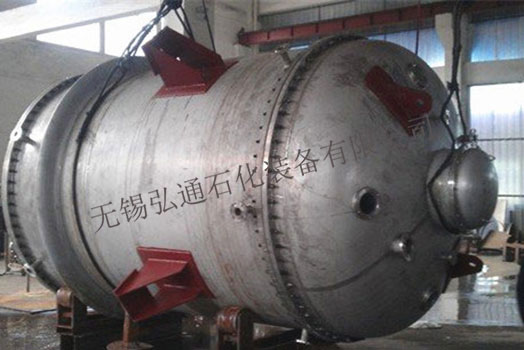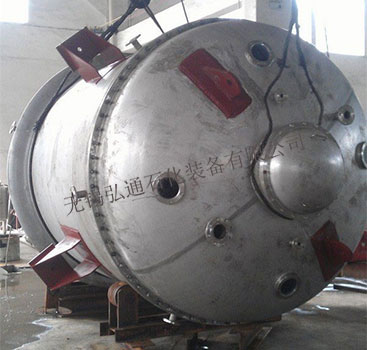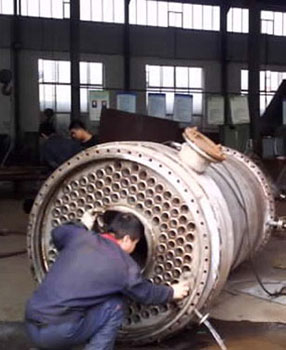熔融結(jié)晶器(靜態(tài)/動(dòng)態(tài)降膜式)/Melt crystallizer(Static / dynamic falling film type)
熔融結(jié)晶目前在中國(guó)未大范圍應(yīng)用���,因此沒(méi)有多值得借鑒的工程經(jīng)驗(yàn)��,所以我司熔融結(jié)晶器設(shè)計(jì)要基于天津科技大學(xué)結(jié)晶過(guò)程研究室的熔融結(jié)晶工藝開發(fā)����。請(qǐng)點(diǎn)擊熔融結(jié)晶工業(yè)應(yīng)用產(chǎn)品統(tǒng)計(jì)����,也可直接點(diǎn)擊網(wǎng)站結(jié)晶技術(shù)博客查閱相關(guān)熔融結(jié)晶工藝開發(fā)及設(shè)備信息�。
Melting crystallizer has not been widely used in China at present, so there is no more engineering experience for reference. Therefore, our design of melt crystallizer is based on the melt crystallization process of the Crystallization Process Research Institute of Tianjin University of Science and Technology. Please click on the melt crystallization industrial application statistics, or the website of crystallization technology blog to obtain the relevant melt crystallization process development and equipment information.
應(yīng)用范圍/Applied Range
熔融結(jié)晶器應(yīng)用于化工中間體��、醫(yī)藥中間體����、生化制品的高純度晶體產(chǎn)品的生產(chǎn)。
Melt crystallizer is widely used in the production of chemical intermediates, pharmaceutical intermediates and high purity crystal products of biochemical products.
產(chǎn)品分類/Product Classification
可分為靜態(tài)熔融結(jié)晶器和動(dòng)態(tài)塔式降膜熔融結(jié)晶器兩種��。
It can be divided into two types: high-efficiency static melt crystallizer and dynamic tower falling film melting crystallizer
結(jié)晶器材質(zhì)/Material
根據(jù)物料特性可用材質(zhì)分為:碳鋼��、不銹鋼及特殊金屬材料��。
carbon steel, stainless steel and special metal materials.
熔融結(jié)晶器優(yōu)點(diǎn)/Advantages
① 實(shí)用性強(qiáng)���,針對(duì)不同的工藝要求選用不同類型的設(shè)備����。
strong practicability, and different types of equipments are selected according to different technological requirements
② 投資費(fèi)用低�����,價(jià)格僅為國(guó)外同類價(jià)格的1/5-1/10�����;國(guó)內(nèi)價(jià)格的1/2-1/6����。
Low investment cost, the price is only 1/5-1/10 of the same price abroad; 1/2-1/6 of the domestic price
③ 操作彈性大,可自動(dòng)控制也可手動(dòng)操作��。
Operation flexibility, automatic control and manual operation are both ok.
④ 設(shè)備緊湊�����、合理�。
compact and reasonable
⑤ 實(shí)際應(yīng)用效果好,結(jié)晶損耗低��。
good application effect and low crystallization loss
⑥ 應(yīng)用熔融結(jié)晶工藝可以使有些復(fù)雜的工藝變得尤其簡(jiǎn)單���。
Some complex processes become especially simple
熔融結(jié)晶器缺點(diǎn)/Disadvantages
結(jié)晶器的結(jié)構(gòu)相對(duì)精餾塔來(lái)說(shuō)�,略復(fù)雜����。需要發(fā)汗、洗滌等步驟����。過(guò)程較復(fù)雜�,過(guò)程的連續(xù)化較困難�。
The structure of the mold is a little more complicated than that of the distillation column. It needs Sweating, washing, etc. The process is complex and difficult to be continuous.
相對(duì)于其它熱分離單元操作,熔融結(jié)晶具有如下優(yōu)點(diǎn):
Compared with other heat separation units, melt crystallizer has the following advantages:
高選擇性��、低能耗�、操作溫度低、無(wú)溶劑��、無(wú)廢液�����、無(wú)氣相�。熔融結(jié)晶與精餾相比較,具有操作溫度低����、所需能耗小等突出優(yōu)點(diǎn)。除以上兩點(diǎn)外���,第三點(diǎn)就是可以利用工廠里其它操作單元所產(chǎn)生的廢熱。因?yàn)楝F(xiàn)有的大部分有機(jī)化合物的熔點(diǎn)都在工廠廢熱溫度范圍內(nèi)�����。
High selectivity, low energy consumption, low operating temperature, no solvent, no waste liquid, no gas phase. Compared with distillation, it has many advantages, such as low operating temperature and small energy consumption. Besides, Waste heat from other operating units in the plant can be utilized. Because most of the organic compounds’ melting point is in the range of the waste heat in the factory.
熔融結(jié)晶與溶液結(jié)晶相比較,由于沒(méi)有添加新的溶劑�,所以避免了溶劑的后處理過(guò)程,這個(gè)優(yōu)點(diǎn)往往可以彌補(bǔ)熔融結(jié)晶的其它缺點(diǎn)���。
Compared with solution crystallization, melt crystallization avoids the post treatment process of the solvent without adding new solvent, and this advantage can often compensate for other shortcomings of the melt crystallization.
熔融結(jié)晶處理的是液態(tài)物質(zhì)�����,液態(tài)相對(duì)于氣態(tài)而言�����,所需要的體積小��,所用設(shè)備體積小�����,投資少�。當(dāng)然�����,如果熔融結(jié)晶需要長(zhǎng)的停留時(shí)間時(shí),則這點(diǎn)優(yōu)勢(shì)就不明顯了��。熔融結(jié)晶過(guò)程沒(méi)有氣體產(chǎn)生��,泄露易于控制��。而且整個(gè)設(shè)備可密閉���,有利于環(huán)境安全�。熔融結(jié)晶不需要添加任何物質(zhì)���,所以沒(méi)有廢液和其它化學(xué)物質(zhì)(溶劑)產(chǎn)生���。要知道,溶劑回收的成本往往占整個(gè)結(jié)晶成本的大部分����。對(duì)于非固體溶液型體系,從理論上來(lái)說(shuō)����,結(jié)晶過(guò)程具有高的選擇性和高的產(chǎn)品純度。
Melt crystallizer deals with liquid substance, which requires a small size and a small amount of equipment, therefore needs less investment. However, if melting crystallization takes longer residence time, then this advantage is not obvious. During crystallization, no gas is produced, and leakage is easy to control. Moreover, the whole equipment can be closed and is more conducive to environmental safety. Molten crystallization does not require the addition of any substance, so no waste liquid or other chemical substance (solvent) is produced. The cost of solvent recovery often accounts for most of the cost of the crystallization process. For the non solid solution type system, the crystallization process has high selectivity and high product purity.


